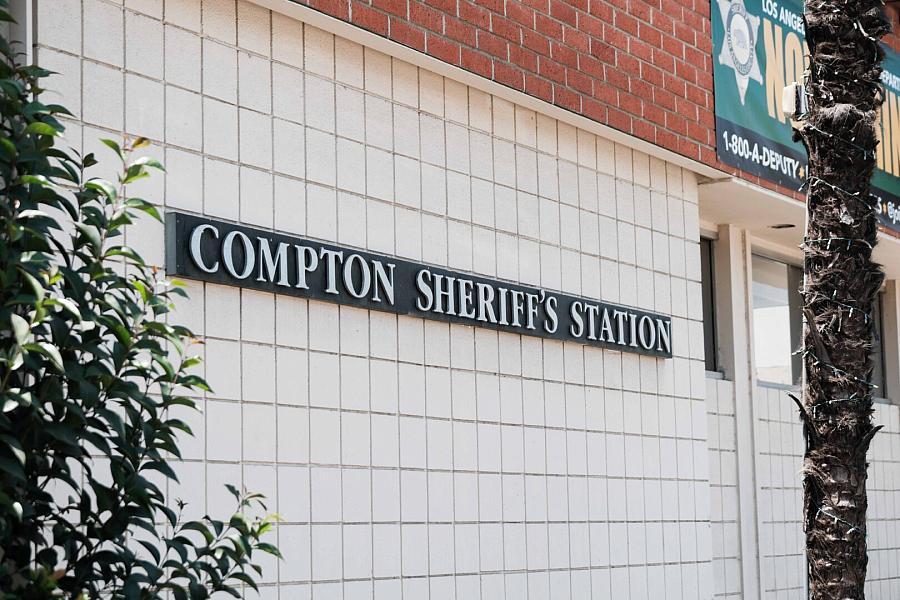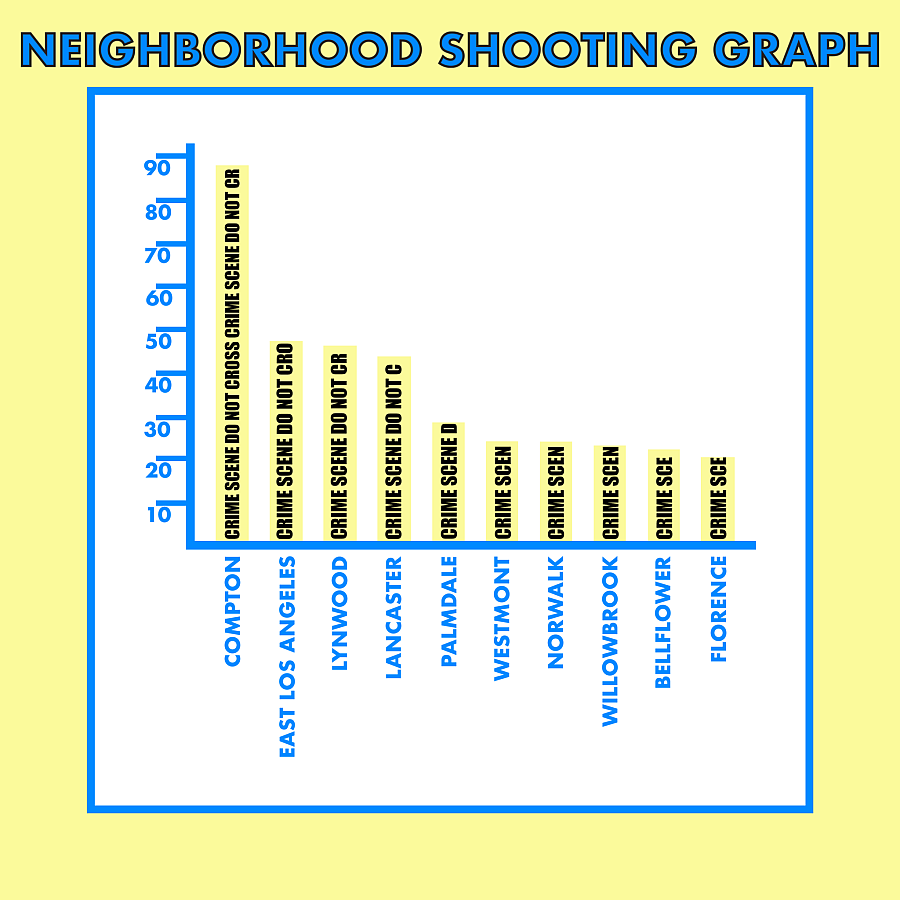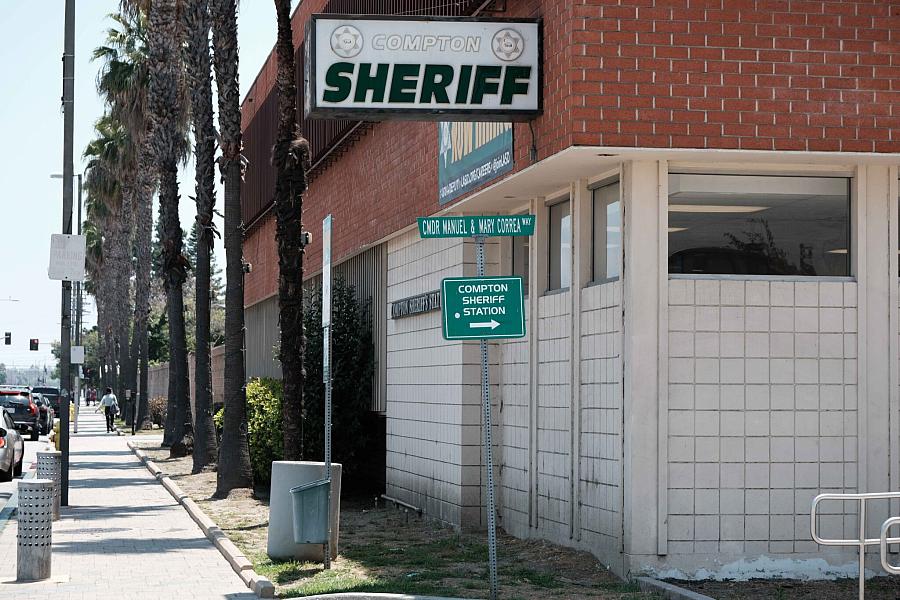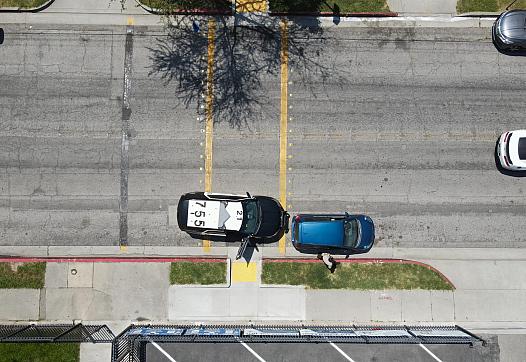Life Under the Gun: An Analysis of Shootings by the Los Angeles County Sheriff’s Department
This project was originally published in Knock LA with support from our 2023 California Health Equity Impact Fund.

An aerial view of a deputy sheriff pulling over a driver in front of a school. July, 2023.
(Photo: Jayrol San Jose | Knock LA)
In the last few minutes of August 17, 2018, 28-year-old Akachi Farmer (whose name has been changed) and two other young Black men rode through the streets of Compton in an acquaintance’s car. A Los Angeles County Sheriff’s Department (LASD) patrol vehicle pulled up behind them, lights flashing. The private vehicle’s driver, also a young Black man, turned down a residential street, and hit a curb. The driver fled the scene, according to the department’s investigative summary of the incident. Farmer climbed out the car’s driver side window, and a deputy fired twice at him.
“They shot at me for no reason,” Farmer told Knock LA. “I was in fear for my life.”
Farmer said he received graze gunshot wounds to his back and arm. The deputy who shot him claimed in his statement to internal investigators that Farmer had a gun.
“I never had a weapon. They said that but never recovered one,” Farmer said. “They’re saying that to justify shooting me when they know they was wrong.” LASD records state that no weapons or rounds from Farmer’s alleged firearm were found.
A yearlong Knock LA analysis of LASD records reveals that, since 1984, at least 916 people have been fired upon by deputies. Of those, 387, or 42%, were killed by the gunfire and 311 were wounded, while the shots missed another 209 people.
Compton, a city of mostly low-income Latine and Black people, is an epicenter of these sheriff shootings. Since 1984, deputies have fired their weapons at 88 Compton residents. On average, one person in Compton, population 93,500, is killed by deputies every year, according to Knock LA’s analysis.
Knock LA’s investigation has revealed that these shootings have left a deep and lasting mental and physical toll on not just the people who were shot — but their families and their neighborhoods.
Nearly all of the people who were shot at were men, and just over half were Latino while a quarter were Black (in comparison, Latinos make up 49% of the county’s total population, while Black people are 9%, according to the US Census). At least 60% of the people who were fired upon were between the ages of 18 and 30.
Many people in Compton told Knock LA that they suffer depression, heart conditions, and other health problems.
Experts say gun violence, regardless of the source, can play a role in many health problems in a community, including heart failure, hypertension, headaches, and post-traumatic stress disorder (PTSD).
“There is a term called secondary trauma where people whose lives aren’t directly affected by a particular event … nevertheless experience fear, insecurity, and traumatic symptoms, simply because of the degree of exposure to that event itself,” said Dr. Lawrence A. Palinkas, a professor of social policy and health at the University of Southern California.
“The more tightly knit the community, the more likely you are to experience secondary trauma,” Dr. Palinkas said.

(Art: Lana Shaw)
Analyzing shootings from 1984 to 2023
A 2018 state law requires disclosure of specific police records, including any incident when a peace officer fires a gun at someone. Utilizing this disclosure law, Knock LA reporter Cerise Castle obtained nearly 1,000 LASD records of shootings dating back to 1984.
The records are incomplete, as the department continues to review and redact the records on a rolling basis. In spite of disclosure laws, shooting records remain heavily redacted. In several records — often those dating prior to 2000 — the names of LASD personnel, their station assignments, and serial numbers have been obscured.
The Knock LA investigation found:
- At least 307 unarmed people were fired upon, which means one in every three were unarmed, according to LASD’s own records.
- In at least 67 cases, deputies reported people holding objects like hair scissors, cake spatulas, and pieces of metal taped together as “armed with weapons.”
- The city of Compton had the highest rate of unarmed people shot at, with at least 29 incidents.
- At least 103 unarmed people were killed by LASD gunfire.
- Internal department investigative reports state that at least 438 people who were fired upon were armed with guns. Some of those reports have been disputed in civil lawsuits by the families of people who were shot.
- At least 1,291 sworn members of LASD out of an estimated 10,000 have fired their weapons at a person. Nearly half went on to shoot at someone again.

(Art: Lana Shaw)
At least two deputies have fired their weapons at more than five people: Angel Jaimes, a self-admitted member of the Regulators deputy gang, fired his gun at seven people. Two were killed, and one person was wounded. Eliezer Vera, an alleged member of the Grim Reapers deputy gang and former candidate for sheriff of Los Angeles County, shot at eight people. He killed 16-year-old Julio Castillo in 1999, and wounded two others in later shootings.
LASD personnel in the southern part of Los Angeles County appear to be involved in shootings more frequently. Deputies at the Century station — located in Lynwood and currently serving Lynwood, Florence/Firestone, Walnut Park, Willowbrook, and Athens Park — were responsible for 32% of the shootings.
LASD did not respond to a request for comment on this reporting.
Unreliable Deputy Narratives
In several instances, the circumstances surrounding the deputy firing their weapon have been inconsistent and the deputies’ reports conflict with evidence.
On June 24, 2014, around 9:50 PM, Antoine Hunter and his friend Geremy Evans, both Black and age 24, were heading home from a vigil for a friend who had recently died, according to their attorney. As they drove, deputies Gregory “G-Rod” Rodriguez, a tattooed member of the Banditos deputy gang, and Timothy Lee, an associate of the Banditos, spotted the car attempting to make a U-turn at the intersection of Rosecrans Avenue and Long Beach Boulevard in Compton, according to an LASD investigative summary of the incident.
The Banditos is a gang made up of deputies that was established at the East Los Angeles sheriff’s station in the early 2000s. Membership consists primarily of Latino personnel who share a common tattoo on their legs — of a skeleton with a bushy mustache wearing a sombrero and bandoliers, holding a pistol. The tattoos are sequentially numbered. Women are not allowed to become full-fledged members.
“I’m pretty sure the attorneys hid from us that they were members of a gang,” said civil rights attorney Humberto Guizar, who represented the families of Hunter and Evans.
The deputies say they began to follow Hunter and Evans and attempted to stop them when the men drove through a stop sign in a residential neighborhood. Hunter was carrying a gun, but kept it tucked away as he drove.
“In that culture you need a gun to survive. They thought maybe other gang members might come and get them,” Guizar said in an interview at his Montebello office. “There was no evidence that they were about to commit a crime. They had it for protection.”
Guizar said the deputies crashed their vehicle into the back of Hunter’s car, lodging it between the deputies’ vehicle and a car parked on the street. The deputies exited their car and began firing into Hunter’s vehicle, killing him. Evans was also hit twice by gunfire, but survived.
The deputies claimed in interviews with internal investigators that Hunter had pulled out a gun when they approached the car, prompting them to shoot. But Guizar says when Hunter’s body was removed from the car, his arms were frozen from rigor mortis in a position that indicated he had been holding the steering wheel when he died. “The detectives didn’t say anything or account for the rigor mortis. Contrary to what Rodriguez said, that he had a gun in his hand. That was a lie.”
Both Lee and Rodriguez were cleared of any criminal wrongdoing by former Los Angeles County district attorney Jackie Lacey. Guizar was unaware of the deputies’ prior shootings and killings until an interview with this reporter. Lee was at the scene of the death of Darren Burley, a Black man who died of asphyxia after deputies kneeled on his neck in 2012. Rodriguez was one of several deputies who shot and killed Edward Angel Ramirez and Rayshawn Marquis Brown in 2013.
Guizar was not surprised to hear Lee and Rodriguez had been involved in other killings. “It’s the same thing, like gangs. It increases notoriety and fear in the community in the end, and the respect among their peers.”

The sign outside of LASD’s Compton station on Willowbrook Avenue. The Compton courthouse is located next to it. July, 2023.
(Ben Camacho | Knock LA)
Ghost Guns
At 5:30 AM on September 10, 2020, deputies arrived at the home of Samuel Herrera Jr. to execute a search warrant. LASD claims that Herrera was a member of a local gang and was selling narcotics out of a garage with a cache of weapons. In the eight years prior to this shooting, Herrera had no contact with any law enforcement agency.
The department’s version of the story is highly contested by lawyers for Herrera’s family. “As I started looking at the 600-page report and trying to piece things together, it turns out that none of that is true,” attorney Hermez Moreno told Knock LA in a phone interview.
Deputies claim that when they arrived, Herrera barricaded himself in the garage and began racking a weapon, or pulling the slide back and releasing it. Herrera’s family attorneys say he had been in the midst of a remodel of the garage and had frequently used a nail gun, which emits a noise that is not dissimilar to a round being racked. Noe Garcia, a lieutenant with ties to the 3000 Boys, Regulators, and Vikings deputy gangs, claims that he heard gunfire and saw a gun’s barrel pointing out of the garage’s window. Garcia began shooting.
Although Herrera set up video cameras in multiple locations inside the garage, no video of Herrera shooting a gun has ever emerged. As Garcia fired, several people, including an infant, were in the line of fire. They quickly emerged from the garage while Herrera remained inside.
“If [Herrera] fired a weapon, you can rest assured that this is the very first video clip they would give us. It is the very first video they would assert in their defense,” Romero said. “Because instead it shows someone in pain, pleading for his life, and the garage starting on fire, they destroyed that.”
Deputy Juan Bendezu heard Garcia’s gunfire and shot off additional rounds. A fire in the garage started simultaneously — the Compton Fire Department has been unable to determine its cause. Herrera attempted to escape by wriggling through an opening in the garage wall into his neighbors’ yard, cutting his face in the process. Neighbors overheard him reciting the Lord’s Prayer in Spanish. Deputies claim he yelled out, “Fuck you!” As Herrera emerged into the backyard, he was shot dead by the deputies. Several continued to fire as he lay on the ground. Inside the garage, several guns were located, prompting the arrest of the home’s other residents. No weapon was recovered from Herrera.
In at least three additional cases, victims’ families have presented evidence in civil court proceedings that contests the investigative report’s narrative. For example, in some cases, family attorneys report that people were shot in the back while turned away from deputies. In others, a gun was found on their person rather than in their hands as deputies claimed.
Impact of Deputy Gun Violence
One city stands out when analyzing the number of shootings: Compton.

(Art: Lana Shaw)
Founded in 1888, the city’s population has hovered between 90,000 and 96,000 for the past 30 years. Once a majority Black city, today it is 69% Latino and 27% Black, according to the US Census. Residents earn a modest median income of about $62,000, and 15% of them live below the poverty line.
Although the city has only contracted with LASD for law enforcement services since the year 2000, deputies fired weapons at people there twice as often as the area ranked second, East Los Angeles.
Since 1984, in Compton:
- At least 88 people have been shot at by deputies.
- At least 30 people were killed by deputies in shootings.
- At least 30 people were wounded by deputies in shootings.
- At least 28 people were shot at by deputies but not struck by gunfire.
On average, one person is killed by Compton deputies every year. By comparison, the city of Plantation, Florida — which is home to 95,000 people, slightly more than Compton but 56% white — has had two fatal police shootings since 2013, according to Mapping Police Violence. Fall River, a 75% white, high-income city of about 94,000 in Massachusetts, hasn’t had a single fatal police shooting in the past 10 years.
Getting to Know Compton
Knock LA conducted a survey of 57 Compton residents between April and May of 2023 related to the impact of LASD deputy shootings. People were contacted at local grocery stores, laundromats, libraries, community centers, and public transportation hubs. Respondents completed questions with reporters in person, online, or by calling a hotline.
This appears to be the first study that attempts to quantify the physical and mental health impacts of shootings by a local policing agency. “I probably couldn’t point to a single study that has quantified those associations in the way that you have,” USC’s Dr. Palinkas told Knock LA.
In their responses, Compton residents reported negative effects on their physical and mental health as a result of deputy shootings.
- 74% said they felt less safe with deputies in their neighborhood.
- 63% said they had personally experienced physical violence during interactions with deputies, or knew someone who had.
- 37% knew someone that had been shot or killed by deputies.

Los Angeles County Sheriff Department’s Compton station. June, 2023.
(Photo: Ben Camacho | Knock LA)
“The vibe is people just don’t like to see they (deputies’) ass. I don’t like to see them and don’t trust them and don’t like them cuz so many people still hurting behind the hurt that they caused,” said James Nelson, an organizer with Dignity & Power Now, a nonprofit dedicated to police abolition.
Dr. Palinkas said this kind of attitude is commonplace in areas where people are subjected to constant trauma directly or indirectly.
- 57% of people who took the survey said they had changed their behavior as a result of interactions with sheriff’s deputies
Changes cited by residents included not leaving their home at night, avoiding walking or exercising in public, and altering their driving routes.
“Those are all examples of hypervigilance, which is a normal reaction to horrific stress and trauma,” Dr. Alfiee Breland-Noble, founder of the BIPOC mental health nonprofit The AAKOMA Project.
However, only 11 survey respondents reported filing a complaint against deputies. None of the complaints were investigated. Several people said they did not pursue a complaint because they believed it would not be taken seriously, had no faith in accountability systems in place, or feared retaliation by deputies.
Interactions with deputies also appear to be affecting residents’ physical and mental health outcomes.
“Symptoms of anxiety or depression can also have physical manifestations,” Dr. Palinkas explained. “If you’re depressed, that can lead to overeating. It can lead to not eating, not having an appetite. People who are depressed or anxious are less likely to get the amount of sleep that they need, and that can have physical health consequences. Oftentimes, people will exhibit psychosomatic symptoms like unexplained rashes, gastrointestinal problems, from being under too much stress and lacking the resources necessary to cope with that stress.”
More than a third of survey respondents reported new physical symptoms or conditions after an interaction with sheriff’s deputies, including:
- Headaches
- Weight loss and gain
- Hypertension or high blood pressure
- Heart failure
- Heart attack
Compton sits in the 87th percentile for rates of heart disease among communities throughout California — which means that its rate is higher than 87% of all communities in the state, according to the state’s Environmental Protection Agency’s Office of Environmental Health Hazard Assessment. The city also has a high rate of low-birth-weight babies — higher than 79% of all California communities. Low birth weight is an indicator of communities where healthcare and healthy food are unavailable. Newer scholarship also explores the role of toxic stress caused by racism and how it can contribute to maternal and infant health.
Several experts say there is a long tradition of research that has documented ties between elevated levels of stress and a weakened immune system, cardiovascular problems, cancer, and other chronic illnesses.
“They have this term called weathering. Over time, there are negative physical health impacts tied to mental health impacts that are also negative from repeated and ongoing exposure to stress and trauma,” Dr. Breland-Noble said. “Those changes that happen physically seep into our DNA. So not only are those changes, physical and emotional, they become a part of how your body is wired and you pass that down across generations.”
Community organizers have received reports of LASD personnel stationed at hospitals interfering with doctors attempting to provide care.
“What we hear from doctors is that sheriff personnel actually interfere with [doctors’] ability to do their job, and [deputies] target their patients, some of whom may have mental health needs or may be in crisis,” said Ivette Alé-Ferlito, executive director of La Defensa, an advocacy organization dedicated to decarcerating LA County jails.
Almost three-quarters of people who took the survey said interactions with sheriff’s deputies had impacted their mental health in a negative way. Several people reported formal diagnoses of PTSD.
Stress, anxiety, and depression were also commonly cited as new symptoms after contact with deputies. One person said that encounters with deputies had “ruined my perspective on life in whole.”
Alé-Ferlito said they has seen this sentiment throughout communities La Defensa mobilizes in.
“In the spaces that we’re organizing in our coalition spaces, even in the county commission spaces where I’m sitting with county departments, everyone understands that sheriff’s violence is real and that the systems that law enforcement have control of are not working — and are not actually helping public safety.”
Some survey respondents coupled these issues with feeling fearful when they see deputies in public, or dealing with anger issues and completely withdrawing socially.
Dr. Palinkas said communities with these symptoms often have widespread diminished trust in others, as well as a reduced sense of safety and security. That results in entire communities that are fractured or splintered.
“Fractured communities are those where people are not looking out for one another, where they feel isolated and cut off, where they feel there are fewer resources available to deal with the unanticipated events,” he said.
Kruti Parekh, an organizer at the youth-led, abolitionist organization Youth Justice Coalition, compared living in a neighborhood patrolled by LASD to living with an abuser. “When individuals are dealing with that level of stress, it always impacts interpersonal relationships,” she said.
“The sheriff’s department is inhumane,” said former Compton resident Skipp Townsend, founder of 2nd Call, a nonprofit that aims to reduce violence and promote community safety. “I feel threatened. I feel intimidated. I feel like my life is in danger. I don’t trust my kids walking home from school, not because of Crips and Bloods — because of the sheriff.”
View the database and map of LASD deputy shootings here.
Read Part 2 of Life Under the Gun here.


